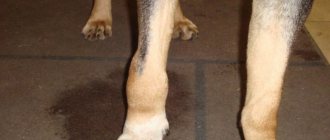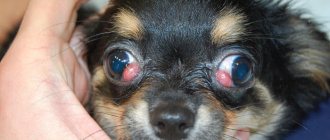Have you ever wondered why dogs go blind? It's common to talk about blindness in older or older dogs, but sudden vision loss in puppies or young dogs isn't always easy to come to terms with. However, it is important to note that, unlike humans, dogs' vision is not as important as their sense of smell or touch. Did you know?
In this article, we'll talk about how to tell if a dog is blind, the causes of sudden blindness in dogs, the most common symptoms of blindness in dogs, and much more. Don't forget to visit a veterinary ophthalmologist to get individual, high-quality advice.
Uveitis - inflammation of the eye
There are many reasons that can cause blindness in a dog. We sometimes talk about this as a relatively normal sign in older dogs, but it can also be a symptom of a more serious secondary condition beyond blindness, such as kidney failure, a case of chronic kidney disease causing metabolic problems. In this case, blindness would be an inevitable consequence.
Since the causes of blindness in dogs can vary widely, a proper veterinary examination is ideally recommended. Remember that some systemic diseases such as ehrlichiosis, babesiosis, toxoplasmosis, leptospirosis, leishmaniasis and many others can cause blindness.
© shutterstock
the dog is blind
The same uniform should be put on the dog when going to the country or on a visit - then your pet will be able to lead a normal lifestyle without requiring increased attention.
We are looking for alternatives
Loss of vision will force the animal to develop all its senses, and the owner’s task is to help the pet learn to navigate space with ease.
Make it a rule to talk to a four-legged blind man - the intonation of your beloved owner’s voice will make it easier to move and will stimulate movement. Communicate with your dog at home and on the street, praise him for successfully avoiding obstacles and warn him about danger: simple manipulations will allow the animal not to feel loneliness and confusion. Learn to comment on your actions, even the most harmless ones: suddenly an outstretched hand may seem like a source of danger to the dog, and the breeder, who was simply petting the animal, will end up being bitten.
To develop your dog’s natural instincts, use toys - puzzles with treats hidden inside, squeakers and any sound toys. It is important to prevent your pet from withdrawing into itself - it will be really difficult to cope with blindness and psychological depression at the same time!
Just in case…
A blind dog is always at high risk. If disoriented in unfamiliar territory, a blind pet will not be able to find its way home and will die on the street. If possible, implant a chip in your dog or buy a collar with a GPS navigator, try not to let your dog off the leash, avoid contact with unfamiliar animals - these simple precautions will help prevent misfortune and guarantee a blind dog a long and happy life.
Dogs
All diseases that lead to vision loss ultimately block the retina. This could be the well-known cataract, glaucoma, age-related changes. Blindness in a dog can be congenital or develop as a result of a brain disease. With a routine external examination, it is impossible to identify the cause of blindness.
Causes of blindness in dogs
The general symptoms of blindness are the same for most diseases. The cause may be injury or pathology of the eye or a nervous disorder: • cataracts – a disease of older animals: • increased intraocular pressure, also known as glaucoma, which can occur in a latent form for some time; • optic neuritis; • corneal damage; • inflammation of the eye membrane; • detachment and degeneration of fiber as a result of hormonal disorders of the thyroid gland, adrenal glands, diabetes mellitus; • uveitis.
Symptoms of Dog Blindness
Dogs' eyesight is not naturally very good. Animals rely more on their sensitive sense of smell and hearing. These feelings become even more acute as vision decreases or is lost, causing the dog to feel relatively confident in familiar surroundings. You can detect a serious vision problem by observing your pet. • First of all, the change in gait attracts attention. The dog tries to raise its paws too high, especially when moving up the stairs, walks very carefully and often bumps into various objects that get in its way. • The dog avoids active games and, when walking, tries to stay away from other dogs with whom a conflict may arise. • On the street, the animal keeps its head close to the ground, trying to navigate by smells. • The dog stops responding to commands with gestures and in general its gaze is not as attentive as before.
Why does my dog have blue eyes?
The eyes are responsible, in addition to capturing images and transmitting them to the brain, for controlling the passage of light, as well as other functions. It is important to note that a small change can damage the eyes, sometimes permanently, leaving the animal blind.
When a dog has blue eyes, we are not necessarily talking about blindness, however, if nothing is done to treat it, blindness can occur eventually and irreversibly. A bluish color, like any other color change, indicates inflammation of the layer of the eye (anatomically we are talking about the choroid), and that is when we talk about uveitis in dogs.
Uveitis can be caused by bacterial infections, viral infections, trauma, or lack of tear production, causing dryness of the cornea and subsequent inflammation of the eye. It usually affects one eye, and if treated early, uveitis should not cause blindness. A visit to the veterinarian is mandatory to begin successful treatment.
Why does my dog have white eyes?
When we notice that a dog's eyes are turning white, it means that he may have cataracts. Cataracts do not occur suddenly but develop gradually, which is why we will notice that the dog's eyes gradually turn white.
This is not always easy to detect, since at first we will only observe the layer of opacity when it comes into contact with light, however, as it progresses we will be able to find that it becomes thicker. As the disease progresses, the eye becomes completely white, and the dog then goes blind.
Like uveitis, this disease can affect only one eye or occur in both. Contrary to popular belief, cataracts do not cause pain to your pet, but they can be inconvenient. Also, there are different types of cataracts, so a good veterinary examination is necessary so that we can know whether it is a permanent cataract or not.
The development of cataracts may be associated with certain pathologies, such as Cushing's disease, diabetes mellitus or hypertension. Avoid using medications or eye drops on people as this may make the problem worse.
What happens when a puppy is born blind?
Puppies can sometimes be born blind due to a developmental defect, but this can also be due to the image receiving cells in the eyes. In this case, the puppy has no obvious symptoms, which is why the owners do not notice it, since the puppy adapts better to the environment, thanks to a much more developed sense of smell and hearing.
There are many reasons, for example, negative prenatal conditions, difficulties during childbirth, malnutrition or pathologies suffered by the mother. Inherited diseases such as diabetes may also be a cause.
© shutterstock
Symptoms of blindness in dogs
But how do you know if a dog is blind? Next, we will show you some symptoms of blindness in dogs that will help you know if your dog is losing vision in one or both eyes.
- The dog constantly rubs his eyes and blinks.
- We observe cloudiness, inflammation or changes in eye color.
- There may also be constant tearing and purulent discharge.
- From time to time or constantly she bumps into furniture and objects.
- Avoid jumps that were previously easy to do.
- Don't go outside or explore an environment you're not used to.
If we notice any of these changes in the dog's eyes, we should consult a veterinarian, preferably a veterinarian who specializes in ophthalmology, to make a correct diagnosis.
SobakinoAbout dogs for people
Each condition that blocks light from reaching the retina results in permanent vision impairment in dogs. The main pathologies that contribute to vision loss are cataracts and corneal damage. Also, blindness in dogs can occur due to increased intraocular pressure, inflammatory damage to the choroid and pathology of the retina.
Clinical picture of the disease
A general eye examination rarely reveals the cause of blindness. However, there are signs that indirectly indicate decreased vision. An animal with a visual impairment may exhibit an overly cautious gait. Cases of collisions with furniture are also identified. In dogs with movement blindness, the nose is close to the ground. In addition, motor activity disorders may occur. This is manifested by the inability to catch thrown objects, etc. As a rule, changes in activity in older dogs are associated with age-related changes. However, in some cases, vision loss is the cause.
Diagnostics
To detect visual impairment in a dog at home, you can use a special test. It is based on the constriction of the pupil in response to bright light. However, this method is not always reliable. This is due to the possibility of reflex reduction of the pupil. To test your dog's vision, you can place the animal in a darkened room with rearranged furniture. In this case, it is necessary to pay attention to the confidence of the pet’s movements and possible collisions with objects. After this, turn on the light and repeat the test. With complete loss of vision, the animal's movements do not change. With a moderate degree of visual impairment, the animal moves more confidently when the light is on. Such tests only help determine the fact of vision deterioration. Determining the level of its reduction is the responsibility of a veterinary specialist.
Treatment of the disease
It must be remembered that blindness or permanent vision loss in dogs is not a catastrophe. According to experts, most healthy dogs do not have good vision. To navigate in space, they use their acute hearing and sense of smell. As a rule, decreased vision in dogs is accompanied by a significant exacerbation of such senses. Therefore, dogs with poor eyesight are able to navigate well in the places in which they lived before the disease. It is not allowed to let the dog off the leash in unfamiliar places. This is necessary to prevent damage. At home, moving furniture is not recommended. This is due to the storage in the animal’s head of information about the localization of various objects. Poor eyesight in a dog is an indication to limit its movements on the street. Walking on a leash is a completely safe walk. In this case, the animal will perceive its owner as a guide.
All dogs can experience blindness. Therefore, it is recommended to prepare the animal for possible loss of vision. To do this, he should be taught basic commands.
To ensure the safety of a blind dog, the following measures must be taken:
- Forming barriers around heating radiators or a swimming pool.
- Isolate all sharp objects. This is especially true for things located at the dog’s eye level.
- Blocking the animal's access to all potentially dangerous places. We are talking about a fireplace, open stairs, etc.
- Using collars with a special keychain or microchip. The keychain must have a note indicating that the dog is blind.
Treatment of blindness in dogs
Once we receive a diagnosis, we will know if our dog's blindness can be cured as this will depend on the degree of blindness and the cause causing the condition and the possible treatment. As in humans, cataracts, for example, can be treated depending on the stage of their development.
It may also be that the disease is irreversible, in which case we need to know that the dog can continue to enjoy a good quality of life if we work at it. Although it may be difficult at first to help you adjust to the new situation, eventually we will be able to continue following a completely normal routine.
Author of the article : Elena Torrence.
Canine progressive retinal atrophy (PRA)
Progressive retinal atrophy in dogs, PAS
(from the English Progressive Retinal Atrophy, PRA) is a genetic pathology that occurs in a dog at a certain age, depending on the breed. The disease develops in both eyes at once and always leads to complete blindness.
Symptoms
The main clinical sign of progressive retinal atrophy in dogs is a decrease in visual acuity in low light, at dusk and in darkness, the so-called nyctalopia (night blindness).
.
However, in a familiar environment for an animal, for example, at home, it may show absolutely no behavioral changes. Ultimately, night blindness progresses to day blindness and then to complete loss of visual function. There is no lacrimation, squinting of the eyes, or discharge with this disease. The dog does not experience pain
.
Dilated pupils and a negative reaction to light (without constriction) are also considered characteristic signs of pathology.
.
Often, dog owners experience excessively bright eyes
(hyperreflexia of the fundus), which is the most important symptom of degenerative changes in the retina. In some breeds, progressive retinal atrophy provokes cataracts.
As mentioned above, progressive atrophy is an inherited disease
, that is, it is passed on genetically from generation to generation. Dog breeds predisposed to this pathology include:
- Alaskan Malamute
- Akita
- American Cocker Spaniel
- English Cocker Spaniel
- Welsh Corgi
- Eastern European Greyhound
- Golden Retriever
- Hound
- Irish Setter
- Yorkshire Terrier
- Collie
- Labrador retriever
- Mastiff
- Norwegian Elkhound
- Papillon
- Pekingese
- Poodle
- Rottweiler
- Russian greyhound
- Samoyed
- Siberian Laika
- Dachshund
- Tibetan Spaniel
- Tibetan Terrier
- Shih Tzu
IMPORTANT! Since this pathology is inherited in an autosomal recessive manner, selection of dogs with PRA is not recommended!
Diagnostics
To confirm the diagnosis and examine the animal for the presence of degenerations, be sure to carry out:
- ophthalmoscopy and funduscopy;
- retinal electroretinography (ERG);
- DNA blood test.
Progressive retinal atrophy in a dog
With ophthalmoscopy
The doctor examines the fundus of the eye for the presence of: hyperreflective tapetal layer, weakened vascular network, optic disc degeneration, etc.
Electroretinography of the retina
carried out to diagnose the reaction of photoreceptors to light (flashes). The study is based on the principle of an ECG of the heart. Important and accurate, it allows you to detect retinal atrophy at an early stage.
DNA test
performed to detect sick dogs, considered the most reliable and basic test for PAS. Healthy animals are used in breeding with those that have any genetic status (sick, carrier, healthy). The research is carried out before direct selection. It is possible at different ages, after receiving a blood sample.
IMPORTANT! No supplement can stop the degenerative process. There is no cure for the disease!
Central progressive retinal atrophy
As with progressive retinal atrophy, retinal pigment epithelial dystrophy (RPED) or central progressive retinal atrophy (CPRA) is genetic in nature and always results in complete blindness.
Unlike PRA, the hallmark of CPRA is decreased visual acuity in bright light or during daytime. Stationary objects are also more difficult to recognize than moving objects, suggesting loss of central vision.
Ophthalmoscopy
provides identification of tapetum hyperreflectivity, thinned vascular network, and changes in the optic nerve head. In this case, numerous spots and areas of pigmentation are diagnosed in the central tapetal area of the fundus.
Breeds : Golden Retriever, Labrador Retriever, Collie, English Cocker Spaniel, Sheltie
may also occur between the ages of 1 and 4 years.
There is no treatment for CPAS
. Accordingly, it is extremely important to competently carry out further breeding work.











